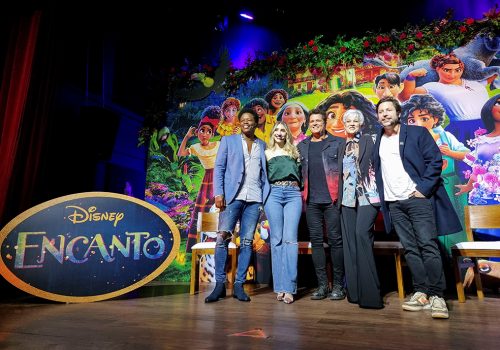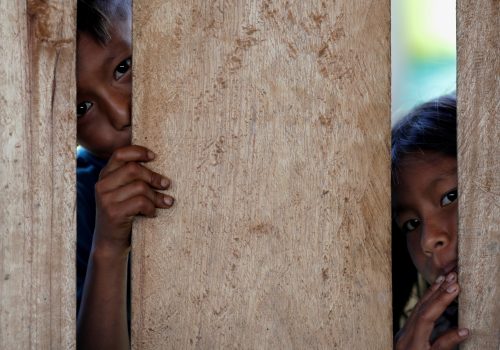Recognize the power of music
WHEN I WAS GROWING UP IN THE PRE-INTERNET 1980s in Cali, Colombia, my father subscribed to Time magazine, and every week, the shiny, ostensible purveyor of everything that was of import in the world arrived in the mail.
I’d scour Time in search of any news—good, bad, whatever—about Colombia. Save for an occasional natural disaster reviewed in a paragraph or two, there never was any. Until Pablo Escobar became the world’s anti- hero in the late 1980s, and except for Gabriel García Márquez’s Nobel prize for literature in 1982, Colombia was mostly absent from global and certainly from US consciousness. I read the dry entry on Colombia in Collier’s Encyclopedia and attempted to make sense of its insufficient information. Was this how people in other parts of the world viewed us? A far-away, underdeveloped tropical nation whose primary assets were a plethora of birds (thank God for that “Colombia is the country with the most variety of birds” stat) and coffee?
When I auditioned for the Manhattan School of Music, a female profes- sor, considered one of the leading pianists of her generation, said: “You’re from Colombia? I have a good friend from Argentina. Perhaps you know her?”
Alas, I did not. But I understood then that even though the distance from Miami to Cartagena is a mere 1,100 miles—while Buenos Aires is 4,410 miles—for many in the Northern Hemisphere, anything South of Mexico was one big blob of sameness—unremarkable save for the extremes of tragedy and crime.
Colombia-and Colombians-were largely invisible
It wasn’t that we had nothing to offer. Colombia had a decent soccer team, even if it never seemed to get past the first rounds of the World Cup. It had Juan Valdés and Gabriel García Márquez. And, to our eternal consternation, in the mid-1980s, it had Pablo Escobar, whose infamy eclipsed all those other blips of achievement.
But, of course, there is a world of difference between notoriety and respect, recognition and scorn.
And then, the music came.
It started almost surreptitiously with Carlos Vives and his new take on vallenato, an almost subversive artistic creation at home (after all, wasn’t vallenato the music of the proletarian masses?) that suddenly found exotic acceptance in the United States.
Then came Shakira with her crossover aspirations, her bilingual hits—a first-ever for a Colombian artist—and her use of Colombian rhythms and patriotic expression. When Shakira sang “En Barranquilla se baila así” in 2005 as she shimmied to the beat of “Hips Don’t Lie,” millions of people, for the first time, looked up her native city on a map.
It took roughly a decade, but now, two generations of musical artists have followed in Shakira’s steps and, almost impossibly, stepped into an international spotlight that was unimaginable in my teen years.
Music has long been the great equalizer. Historically, it has crossed barriers of race, class, politics, nationality, and language, with music in English— the world’s vast lingua franca—consumed by people from around the world. Thanks in no small measure to a growing contingent of Colombian super- stars that includes Shakira, Juanes, Maluma, Camilo, and J Balvin, music in Spanish has also sliced the language barrier and is listened to broadly by non-Spanish speakers worldwide.
How did this happen? Our circumstance as a country in near-perpetual conflict favored the development of music as an alternative, outlet, and solution. Yet, music was long insular in Colombia. We listened to local acts and imports from the United States, Spain, Argentina, and Mexico, as did most Latin Americans. Colombia was a depository of music from other places, but our own rhythms and beats were regarded as too, well, Colombian ever to be appreciated outside the confines of our borders.
Seen dispassionately, the evolution of Shakira is almost miraculous. As a young girl growing up in Colombia in the 1980s and 1990s, there was no one she could artistically emulate or aspire to and no industry to viably sup- port her brand of youth-oriented, slightly rebellious rock. Shakira not only managed to set foot outside Colombia into other Spanish-language countries but improbably pierced the veil of mainstream acceptance, becoming a global superstar who sang in English, recognized on equal footing with artists like Madonna and Ricky Martin in their heyday. It had never happened before to one of us. Once Shakira was able to break that barrier, possibilities unfolded for new generations.
After all, the musical movement borne out of Medellín is a post-narco phenomenon, fueled by young artists who sought to depict their social malaise through music and strove to get ahead through musical art that came from their very own streets and culture, rather than through violence or conformism.
When J Balvin showed “molas,”1Molas are colorful pieces of stitched artwork created by the Indigenous Gunadules community (also known as Kuna) in Colombia. Kuna women design and sew Molas, which they wear as part of their traditional clothing. “palenqueras,”2Palenqueras are afro-Colombian women who wear vibrant, colorful dresses and balance bowls of tropical fruits in their heads, particularly in the streets of Cartagena. They are direct descendants of the world’s first free African slaves, established in San Basilio de Palenque in the southeast of Cartagena. Today, Palenqueras stand as one of Colombia’s most iconic national symbols. and “chivas”3Chivas are colorful, rustic buses typically used in rural Colombia as a form of public transport. in his video of “Mi Gente” (my people), he served as a de facto ambassador for Colombian culture and folklore, placing it on a platform that allowed for its mass consumption. When Maluma tattooed the word Medellín on his famous chest and sang using the colloquial language of his city’s streets, he turned preconceived notions of Latin crooners on their heads, offering the image of the singer as a patriotic symbol instead. When Camilo sings “No es vida de rico, pero se pasa bien rico,” (“It’s not a rich man’s life, but we have a great time”) he speaks not just for millions of young Colombians, but for the millions of young Spanish speakers who tackle their struggles with humor.
Yet, until just a few years ago, the fact that musicians were leading the fray in terms of raising Colombia’s visibility abroad was widely discounted. Until relatively recently, music was seen as mostly a trivial pursuit, certainly not a “real” career, and unworthy of serious consideration by influential decision makers and politicians.
Except, musicians overall have become the decision makers, and Colombian musicians, in particular, have become global leaders. This is obvious, not just in terms of fame—easily measurable nowadays by the number of social media followers and music streams and downloads, but also in terms of tangible social and economic impact and influence. Colombian musicians today are the single most recognized ambassadors of the country’s culture, folklore, and traditions and are also vocal agents of change. Witness Shakira’s Fundación Pies Descalzos (Barefeet), Juanes’s Fundación Mi Sangre (My Blood), and Maluma’s ElArtedeLosSueños(the Art of Dreams) foundation. Not only do they transform lives inside Colombia, but they raise the country’s equity everywhere.
And now we have Encanto, an animated Disney film remarkable for its sheer visual beauty (which reflects the beauty of the Colombian countryside near the coffee-growing region where the mythical casita stands), uplifting family themes, and joyful music, much of it performed by—Oh My Good- ness—actual Colombians! At the time of this writing in March 2022, the film’s soundtrack had spent eight non-consecutive weeks at No. 1 on the fabled Billboard 200 chart, which measures consumption of all albums in every genre. No soundtrack has ever done that in the chart’s history.
That’s not the only record it’s set. Encantois the first soundtrack to go to No. 1 since 2019 and the sixth animated soundtrack to ever top the chart.
Beyond that, Encanto is a film set in Colombia, with a predominantly Colombian cast that sings and speaks in Spanish and English. Animated or not, this degree of exposure and success for our country is unprecedented on the screen.
As Colombian actor John Leguizamo, who voices Bruno in Encanto, once told me: “It’s more common to see aliens than Latinos on mainstream film and television.” And Colombians? Aside from Leguizamo and Sofía Vergara, there are no other actors you can name off the top of your head.
For years, movies about Colombia were filmed elsewhere. Such block- busters as Collateral Damage and Clear and Present Danger, for example, were both shot in Mexico because Colombia was deemed too dangerous, and Colombian characters were played by Mexicans or Spaniards speaking with the wrong accent.
Encanto, on the other hand, really minded its Ps and Qs, from accents to outfits to minute details like the hand-painted tableware, the embroidered dresses, the food, the various colors of our skin, and the animals— from the ubiquitous toucan to the yellow butterflies that are synonymous with García Márquez.
Many years ago, I asked Carlos Vives–who performs two songs in the soundtrack—if he thought his music was too regional and Colombian root- based to attain international success.
“Being local is what allows me to be international,” he replied, way ahead of his time. It’s not surprising, with this mentality, that Maluma and Sebas tian Yatra, another new-generation Colombian singer, are also featured in Encanto.
The year 2021 was a watershed year for Latinos in film, with In the Heights, West Side Story,and Encanto featuring Latin lead actors, none of them hugely famous. After all, it’s been a year of breaking parameters, zeroing in on inclusivity and diversity, and looking beyond the well-mined bubbles. But in film, the only major success thus far has been Encanto, a musical and arguably the narrowest in scope. What made it work?
I want to think Colombia and its music made it work. Yes, the country is indeed that dangerous, with thousands displaced from their homes every year because of violence, as the film superficially shows. But it’s also that beautiful, that exuberant, that passionate, that family-oriented, that hospitable, that delicious, that musical, and yes, that magical.
Now, that musicality is systematically finding its way to the rest of the world. Music isn’t something you can taste or smell, like our coffee, or see and touch, like our birds. But thanks to an ever-growing number of artistic collaborations and an increasingly solid business infrastructure, it’s become perhaps the most effective and widely-lauded vehicle to transmit eminently Colombian emotions to the world, without constraints of borders or language.
At the 2022 Academy Awards, Encanto, an animated musical based in Colombia and proudly featuring Colombian voices and sounds, won Best Animated Feature. At the 2022 Grammy Awards, there were eight nominees from Colombia in the four Latin categories, more than any other country.
It’s not just about what happens with our music on an international stage. Inside our borders, for perhaps the first time ever, there’s a multi-tiered, highly-profitable music industry that allows inspiration to have a ripple effect that reverberates throughout the local economy: from the recording studio to the 50,000 tickets Karol G sold to her show at Estadio Atanasio Girardot in Medellín.
At a recent international award show, Maluma performed with four fellow artists from Medellín, all wearing t-shirts that said: “Medallo en el Mapa,+ Música– Violencia,” (Medallo4Colloquial name given in Colombia to the city of Medellín. in the Map + Music – violence).
The message was proud, but also defiant.
Thanks to music, we are finally being seen and heard. And we are making change happen.
Portions of this essay originally appeared in the article by Leila Cobo published by Billboard on January, 2022 “With ‘Encanto,’ Colombia Is Finally Seen and Not Just Heard,” accessible here: https://www.billboard.com/music/latin/encanto-colombia-positive-image-1235017931/
Related Allies essays
A roadmap for a new type of engagement
This moment opens the door for a reimagined US partnership with Colombia based on a shared vision for a more prosperous, inclusive, and sustainable future.
Related program

The Adrienne Arsht Latin America Center broadens understanding of regional transformations and delivers constructive, results-oriented solutions to inform how the public and private sectors can advance hemispheric prosperity.
Image: "Klama" dancers perform during the "Battles of the Flowers" parade as part of carnival celebrations in Barranquilla March 1, 2014. REUTERS/John Vizcaino (COLOMBIA - Tags: SOCIETY)


